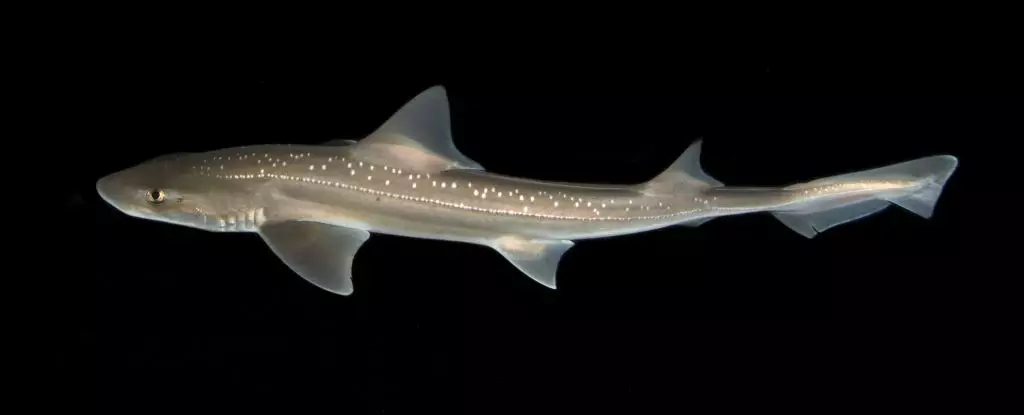For decades, sharks have lingered in the depths of our collective imagination as silent predators that navigate the ocean with eerie grace. This portrayal has shaped our perceptions of these majestic creatures, reinforcing the myth that they glide through the water soundlessly, evoking both fear and admiration. However, recent discoveries challenge this long-held misconception, revealing that these apex predators may not be the voiceless hunters we once thought them to be. Scientists have confirmed that sharks, specifically the rig (Mustelus lenticulatus), can produce a distinct clicking sound, diminishing the notion of their silence and opening an entirely new chapter in understanding their behavior and communication.
The groundbreaking research led by Carolin Nieder of the Woods Hole Oceanographic Institute highlights the importance of revisiting what we think we know about sharks. In a perplexing turn of events, the discovery of their ability to emit sounds has transformed the narrative surrounding these animals, inviting a reevaluation of their social behaviors in the oceanic ecosystem. As the research unveils, it is possible that these clicks are not mere artifacts of stress but a form of communication—an evolutionary edge that could redefine their interactions within the marine world.
Unveiling a Complex Communication System
The significance of sound in the animal kingdom has been well documented. Underwater, sound waves can travel long distances, and various species have developed unique mechanisms for vocalization. For sharks and their relatives, the elasmobranchs, this ability was thought nonexistent due to their anatomical features—or lack thereof. So, the revelation that rig sharks and other related species can create clicking sounds raises intriguing questions about the social dynamics among these creatures.
The implications of this discovery hint at a rich tapestry of interactions that may have previously gone unnoticed. Could these clicks serve various purposes, from attracting prey to alerting peers or even signaling distress? Unlike dolphins or whales with complex vocalizations, the newly observed click may open avenues to investigate a fundamental aspect of shark behavior: communication. The diversity in vocalization techniques seen across marine life makes the potential for a complex elasmobranch language not impossible, but rather an exciting frontier in marine biology.
Behavioral Insights: Sharks in Captivity
The experimental setup employed by the researchers, involving the handling of juvenile rigs in a controlled environment, offered critical insights into how these sharks produce sound. The study recorded high-frequency clicks averaging 48 milliseconds—sounds powerful enough to register as loud as a gunshot. Analyzing the context of these noises, it appears that they are primarily emitted as a response to stress rather than during natural activities such as swimming or feeding. The researchers made significant observations that the sharks clicked more vigorously when first handled, suggesting that the sound production aligns with a distress response that could diminish with habituation.
This tells us something profound about their behavioral ecology. Are these communication attempts genuinely unintentional, born of anxiety, or do they serve a strategic purpose in their natural environments? The whispers of these ocean giants could provide vital clues to their social structure and survival instincts, urging us to reassess their roles in marine ecosystems. The riddle of whether rigs are aware of their own vocalizations adds a tantalizing layer to our understanding of their social capabilities.
Potential Communication Strategies: Are We Listening?
As Nieder and her colleagues move forward with their investigation, the future of shark studies stands at a precipice of new explorations. The questions surrounding the purpose of these clicks remain largely unanswered, but the possibilities are boundless. If rigs can indeed hear their own clicks, it opens the pathway to understanding whether inter-species communication occurs, or if they function as a personal alarm system. There’s also the consideration that these sounds might mimic the noises of snapping shrimp—an innovative hunting strategy that complicates the perception of sharks as mere predators relying solely on brute force.
The multidimensional aspect of shark communication appears brighter than ever before, but it calls for a paradigm shift in how we perceive and study these iconic fish. The implications could extend to conservation efforts, shifting the narrative from seeing sharks purely as threats—often fueled by media portrayals—to understanding them as participants in complex ecological networks.
The ocean has long muted the conversations of its inhabitants, and as we begin to tune in, it is essential to advocate for a narrative that respects the intelligence and capacity for communication possessed by sharks, steering public perceptions towards a more nuanced appreciation of their role in marine ecosystems. In understanding sharks, we uncover hidden depths not only in their natural history but also in our relationship with the vast oceans they rule.

